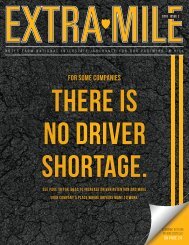ExtraMileIssue9
Create successful ePaper yourself
Turn your PDF publications into a flip-book with our unique Google optimized e-Paper software.
14<br />
New drivers and new trucks cost money, and XYZ does not have the<br />
cash flow to be able to invest in growth. Not identifying tactics and<br />
metrics is leading to some big problems.<br />
XYZ tackles the problem by using steps from The Engagement Model.<br />
The first thing they do is identify the minimum margin they need for<br />
new business, which helps them identify the minimum bids they’ll<br />
place for loads on the load board. Second, they communicate capacity<br />
to everyone in customer service and sales. Third, they focus sales<br />
efforts on acquiring a specific percentage of additional business from<br />
existing customers (which was a target they had previously identified).<br />
Fourth, they create measurable goals around current and past<br />
customers to call for new business and referrals. Last, a monthly sales<br />
activity report is created to track all important metrics.<br />
Finally, to solve the cash flow issue, XYZ decides that they’ll explore<br />
partnering with a factoring company – at least in the short-term.<br />
Action Items & Innovation<br />
Tactics and metrics lay out the options for meeting the specific<br />
objectives that ultimately roll up to your strategic goals. But you can’t<br />
know everything that will come up throughout the year ahead and<br />
not everything always fits neatly into achieving one specific goal.<br />
Additionally, a tightly-controlled plan doesn’t allow for innovation or<br />
failure. While no one enjoys failure, missing goals and objectives<br />
happens – especially when you’re trying something new. You must<br />
have flexibility in the plan to account for that possibility.<br />
Action items are more specific than tactics (e.g. buy new invoicing<br />
software). To identify action items, ask your relevant team members to<br />
come together. Share the overall strategic goals you’ve identified, the<br />
tactics and metrics. Then, brainstorm around what specific actionable<br />
steps the team members could take to meet any of those goals or<br />
targets. Have the team identify possible new solutions or actionable<br />
steps. Nothing is too far out there when you’re generating ideas,<br />
because you’ll decide later what you want to try.<br />
While this step of the process may seem a bit more intensive, it does<br />
help engage employees. It also reveals solutions and possibilities that<br />
you, as a leader may not have even thought about. Further, people<br />
are more willing to commit to actions or goals that they had a hand<br />
in creating.<br />
Once you’ve outlined all the possibilities from the brainstorm, engage<br />
in some discussion and identify two to three actionable steps you<br />
want to commit to for each of your tactics.<br />
One Example:<br />
XYZ Trucking has brought the team together to communicate the<br />
big goals of its strategic plan and some of the tactics they think are<br />
necessary. They’ve identified the need to increase the fleet and bring<br />
in more business. Since these are aggressive targets, the CEO wants<br />
to ensure everyone is onboard and ready to roll.<br />
The discussion with the team is very helpful. People share their<br />
concerns about the apprenticeship driver program. Harry, one of<br />
the more tenured drivers, speaks up that he’d actually enjoy the<br />
opportunity to be a mentor. They all decide that as part of the process,<br />
they’ll take a new driver on three runs for the initial evaluation. They<br />
proceed to outline some of the other steps to deciding if and when<br />
an apprentice becomes a driver, including how/if XYZ pays for all the<br />
training and certification or a part of it.<br />
A lot of other options are discussed like providing a bonus to drivers<br />
who submit a referral for additional business from a current customer<br />
or from a potential new customer.<br />
They discuss some options to address long drive times and<br />
scheduling drivers to take advantage of preferred routes when<br />
appropriate. They even talk about allowing some drivers to go parttime<br />
instead of retiring.<br />
XYZ doesn’t put resources into every idea, but it’s clear there’s a lot<br />
of opportunities for growth and everyone from the truckers to the<br />
accounting folks are engaged and ready to go.<br />
Measurement and Realignment<br />
We’ve mentioned metrics a few times. Both quantitative and<br />
qualitative data is valuable. There should be a plan for how often you<br />
review numbers, and at what points you want to rethink some aspect<br />
of your strategy if things aren’t going well. Or, when to consider doing<br />
more if things are going exceptionally well.<br />
Specifically, look at each metric you’ve outlined. The ask yourselves:<br />
1. How often and when will we look at progress in this metric<br />
to see if we’re on track?<br />
2. What are some of the things that could happen that may<br />
cause us to not meet the target metric? Are these factors<br />
under our control?<br />
3. If we miss or exceed a metric, will that trigger a reevaluation<br />
or some action? If so, when?<br />
4. What are potential options if we miss a metric? What if we<br />
do better than expected?<br />
5. If we aren’t meeting a goal, instead of abandoning it, should<br />
we change it or the goal timeline?<br />
Additionally, if you’re taking on a significant new venture, consider<br />
deciding when you think it may be best to step away. Determine when<br />
you’d know it isn’t working and how you’ll move on.<br />
Conversely, what if things are going much better than expected?<br />
What if the phones are ringing off the hook? What plans are in place<br />
to increase capacity, or to invest revenues that are growing faster<br />
than expected?<br />
One Example:<br />
XYZ Trucking had business they might have to turn away because they<br />
were at capacity. Cash flow was where it needed to be to invest in<br />
growth, but they were not meeting recruitment targets for the number<br />
of applicants, new hires or apprentices.<br />
Instead of abandoning the goal, XYZ reevaluated. They went through<br />
the Action Items & Innovation step to brainstorm some ideas. One<br />
suggestion was to do more brokering. They may not make much (or<br />
any) margin, but they could keep the customer until they are able<br />
to hire additional drivers. Another idea was to bring back well liked<br />
retired drivers on a part-time basis to recruit and mentor newer drivers<br />
and help build a more engaged driver force.<br />
Now, XYZ had options to explore that would keep them on the path<br />
towards their strategic goal.<br />
Engaging Employee Support<br />
You do not succeed alone. You already know that you rely on your<br />
employees to bring their best selves to work and their best ideas to<br />
the table. We’ve alluded to how you can engage employees through<br />
certain steps of the process. Below are three ideas on inviting the<br />
participation of team members that will ensure the success of your<br />
strategic plan.<br />
➼➼<br />
In addition to sharing your big goals on posters or boards for<br />
everyone to see, consider making other aspects of your strategic<br />
plan public - like the metrics for success. You may also want to<br />
lay out some aspects in the form of a well-designed online or<br />
print document.<br />
➼➼<br />
On at least one occasion, bring employees together as a group<br />
to discuss how the strategic plan fits in with the purpose and<br />
aspirations of your company. Invite employees to share how<br />
they think they can make the plan a reality. One way to do this<br />
is at table discussions. Let each table identify and then share<br />
their best idea with the larger group, so that excitement builds.<br />
Document all of the ideas and share the best of them with the<br />
broader organization. Then act on them!<br />
➼➼<br />
Share milestones and wins within the organization. Most<br />
importantly, recognize the contributions of all those involved.<br />
Recognition validates a person’s efforts and ensures they feel<br />
that exceptional work is rewarded.<br />
If you do no other thing we outline in the model, do this – engage<br />
your employees.<br />
In absence of a solid strategic plan, in absence of a plan for execution,<br />
engaged employees will accelerate growth and success. Engaged<br />
employees are more attuned to customers. They’re more innovative<br />
and solutions-oriented. They invest more of their discretionary effort –<br />
which is that extra something that makes them willing to go above and<br />
beyond the daily minimums to “get the job done.” Engaged employees<br />
are ambassadors to your company and the stewards of your brand.<br />
Coming Full Circle<br />
Based on The Engagement Model, you can see that in executing<br />
the strategic plan, it’s transformed into a living document. As you<br />
initiate change in your organization, as the market changes and as<br />
customers respond to both, pausing to review if you are aligned with<br />
your purpose, and assessing the company’s current state, helps to<br />
recalibrate. It creates an impetus to review employee engagement.<br />
We think using the Engagement Model for Strategy Execution to<br />
continually reengage with your strategic plan and make adjustments<br />
will allow you to weather shifts, seize opportunities and embrace<br />
change and people as a source of competitive advantage.<br />
About the telos institute:<br />
At telos, our focus is at the crossroads of our clients’ most critical<br />
issues and highest leverage opportunities: business strategy, leadership<br />
development and change management.<br />
Operating globally, cross-pollinating successful mindsets, processes<br />
and approaches across all industries, telos tempers deep functional<br />
expertise with broad insight to drive transformational outcomes.<br />
From large-scale, enterprise-wide interventions to smaller targeted<br />
initiatives, our consultants are equally experienced working in<br />
C-Suite settings or starting in the middle of organizations and<br />
building momentum.<br />
For more information, please visit http://thetelosinstitute.com/.<br />
15
















